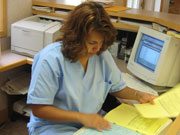   |
|
Bleach Your Teeth Crowns Dental Anesthesia Dental Implants Dentures: Get Your Smile Back Extraction of Wisdom Teeth Flossing Fluoride and Your Health Night Guards/Splints Nutrition & Dental Health Oral Cancers Porcelain Laminate Veneers Pregnancy and Oral Health Root Canal Therapy Temporomandibular Disorders TMJ/TMD The Right Time for Braces Tooth Decay: A Preventable Disease Women's Dental Health Your Child's First Dental Visit Your Child's Teeth and Gums: Tips for Parents |
Here are a few ways you can help your children get a head start on having a healthy mouth and smile. **Wipe your infant's gums after each feeding with a damp washcloth or gauze pad to remove plaque and food residue. Clean baby teeth as soon as they come in with a soft cloth or a baby toothbrush. **Avoid putting your child to bed with a bottle at night or naptime unless it is filled only with water. Baby Bottle Tooth Decay occurs when children fall asleep with a bottle of milk, formula, juice, or other sweet liquid in their mouths, but it can also develop when children fall asleep while breast-feeding. **Take your baby to visit the dentist after the eruption of the first tooth. **Schedule visits to the dentist at a time when your child is likely to be well rested and cooperative. **Never mention the words hurt or pain around your child when discussing an oral health visit. Saying, "It won't hurt." instills the possibility of pain. **Allow and encourage your child to dis-cuss any fears he or she might have about oral health visits. **Start teaching your child proper brushing techniques around age two. Control the amount of toothpaste your child uses. Administer only a pea-sized amount on the brush. Until he or she is over age four, teach your child a simpler brushing technique than the one you use. You can do follow-up brushing and flossing until your child is able to handle the job alone. However, you should supervise until your child is at least eight years old and able to complete the task alone. **Consider sealants when children's perm-anent molars erupt (usually around ages six and twelve). Sealants are thin protective plastic coatings placed on the chewing surfaces of back teeth. Research has shown that using sealants can cut molar cavities by more than 50 percent. Ask your dentist for more information. **If your child has braces, be sure to ask your dentist about orthodontic toothbrushes, electric toothbrushes, floss threaders, and other interdental appliances to help keep spaces between teeth and archwires clean. **Offer your child fruits and vegetables for snacks instead of candy and cookies. Limit snacking to one time between meals, making sure he or she brushes afterward. **Continually remind your child about the benefits of good oral health and stress the role that nutrition plays in maintaining it. **Protect your child's mouth by using car seats. Insist on mouthguards during athletic activities, and discuss dental emergency procedures with your dentist. **Teeth are sometimes knocked out when accidents occur. Act quickly as time is important. Gently clean the tooth in running water without scrubbing, then insert and hold the tooth in its socket. Then get the child to the dentist immediately so the tooth can be fixed in place. If you cannot replace the tooth in its socket, keep the tooth wet by placing it in milk. The tooth could also be placed under the child's tongue to keep it moist, or as a last resort, put the tooth in water or wrap in cellophane. Then get the child to the dentist quickly (within 30 minutes if possible). **Set a good example for your child by brushing, flossing, eating healthy foods, and regularly scheduling oral health visits for yourself. **Change your child's toothbrush three to four time per year, and after every illness. Ask your dentist or pediatrician to prescribe fluoride drops or tablets. In this form, fluoride is beneficial up to about ages 11-12. Napa currently does not have fluoridated water. This should change in the near future. Posted 2-22-98 [TCJ] |
Questions - Comments - Suggestions
Should you have questions about any aspect of dental disease or treatment, or,
have a specific problem or treatment need, contact us at:
Phone: 1.707.255.3007 or E-Mail: dentist@johnsondmd.com
Address: 3434 Villa Lane, Suite #100; Napa, CA. 94558
© Copyright 2007, Thomas C. Johnson, DMD, Inc. All Rights Reserved.
